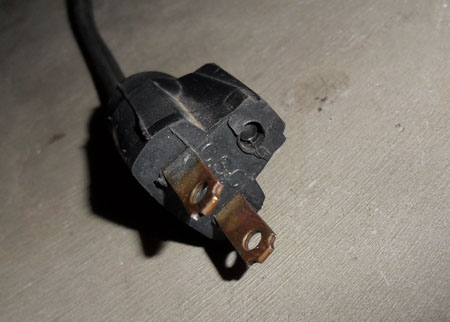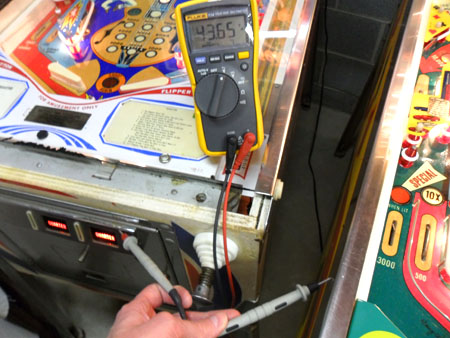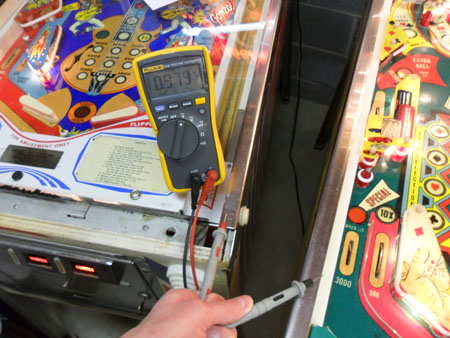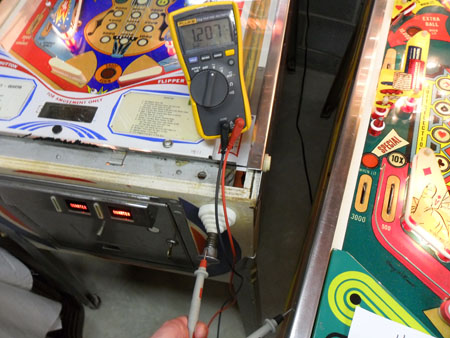Repairing an Electrical Plug With Ground Pin Cut Off
Author: Wayne Eggert
Date: 5/15/2011
Introduction
This is a repair on an 125v A/C electric cord on a pinball machine that had its ground pin cut off. The pinball machine would appear to function correctly, but when standing barefoot on a cement floor or while at the same time touching another device that was properly grounded the machine would deliver a nasty shock! This repair would be applicable to any device meant to use a 3 prong grounded plug, that has had its ground pin cut off.
What is Grounding? Why Is It Needed?
Grounding is very important in electronic devices, but especially higher voltage devices like pinball machines where incorrect grounding could cause an unintended shock to the user. The ground provides a common electrical voltage point of reference and also safety to humans by allowing a path for excess electrical currents to follow.
Today's modern US electrical wiring consists of three separate wires: black, white, and green. The green wire is always the ground and connected to the ground pin on the plug. The opposite end of the ground wire connects to the chassis of the equipment. The black wire is considered the "hot" wire. The white wire is the "neutral" or "common" wire. Some cords do not have color coded wires for hot or neutral but instead mark the neutral wire with writing, ribbing, ridges or texture. The ground wire from the device's plug connects to the ground on the electrical outlet, which connects back at the circuit breaker to the ground loop of the house (usually copper plumbing) and finally to "earth ground" outside the house.
Most appliances or devices have their power switch on the "hot" wire. Polarized or grounded plugs prevent the user from plugging in a device backwards. With the power switch on the "hot wire" this guarantees no voltage will reach the device when the switch is turned off. If the plug is non-polarized or the ground pin is cut off of a 3 prong plug, it could allow someone to insert the plug backwards. This would create a shock hazard even if the device was off since the power switch would be on the neutral/common wire and the hot wire would be directly connected to the device!
The "Lively" Pinball Machine
So back to the repair at hand, a pinball machine that has had its ground pin cut off on the plug. The "hot" and "neutral" blades on the plug are not polarized, since the non-existent ground pin would have only allowed the plug to be plugged in one way. This unfortunately allows the pinball machine's plug to be inserted incorrectly into the outlet and create a shock hazard even when the machine is switched off.
Picture: Ground Pin Cut Off of 3-prong Plug
Upon taking some voltage measurements, we can see why grounding is important for a higher voltage device like a pinball machine. While some of the metal on the machine is not carrying very much voltage, the coin door was found to be around 43v A/C (solenoid / coil voltage on this pinball machine).
Picture: Coin Door Voltage (red lead on coin door, black lead
on adjacent properly grounded pinball machine)
The side rail A/C voltage did not measure very high, around 1v A/C.
Picture: Side Rail Voltage - around 1v A/C
Plunger voltage also did not measure very high either.
Picture: Plunger Voltage - also not very high, a little over 1v A/C
So we have points of references for the voltage prior to fixing the plug. It should be noted that the real "killer" when it comes to electricity is the current, not voltage.
Dangers With Electricity
It's a common misconception that higher voltage is more dangerous than lower voltages. The danger is actually in the current flowing between two points. Since V=IR (voltage = current x resistance) it's easy to see why people would assume that higher voltage is more dangerous. Since V is directly proportional to I, higher voltage can also mean an increase in current if the resistance stayed the same.
The greater the current, the more dangerous it is to humans -- but the damage also depends on what part of the body the electricity is flowing through since parts of the body have different resistances. This is why you may hear people say to keep one hand in your pocket when working with high voltages in order to not take any chance of having the current flow from one hand to the other (across the chest). It's interesting that a current of 0.2 amps can be potentially fatal. It also takes less A/C current to cause damage than D/C current.
"In general, for limb-contact electrical shocks, accepted rules of thumb are: 1-5 mA is the level of perception; 10 mA is the level where pain is sensed; at 100 mA severe muscular contraction occurs, and at 100-300 mA electrocution occurs."
Carr, Joseph J. Safety for electronic hobbyists. Popular Electronics. October 1997. as found in Britannica.com.
This is not to scare you from working with anything electrical, but just to make you aware of some of the dangers of electricity. Many people that don't even attempt rewiring or working on anything electrical have been shocked by a malfunctioning device or improperly grounded appliance. When I was a child I got shocked by a canister vacuum cleaner -- and a few years later had one catch on fire, so that could explain why I tend to avoid vacuum cleaners to this day! All jokes aside though, it's amazing how many of us just take electricity for granted without really understanding anything about the lights, switches, electrical outlets or appliances we use on a daily basis and the dangers that are always there. But just like driving a car, riding on an airplane, or crossing the street -- the dangers are always there but they are minimized when safety is practiced.
Anyway, back to the repair, let's fix this plug!
Comments:
No comments have yet been made.
